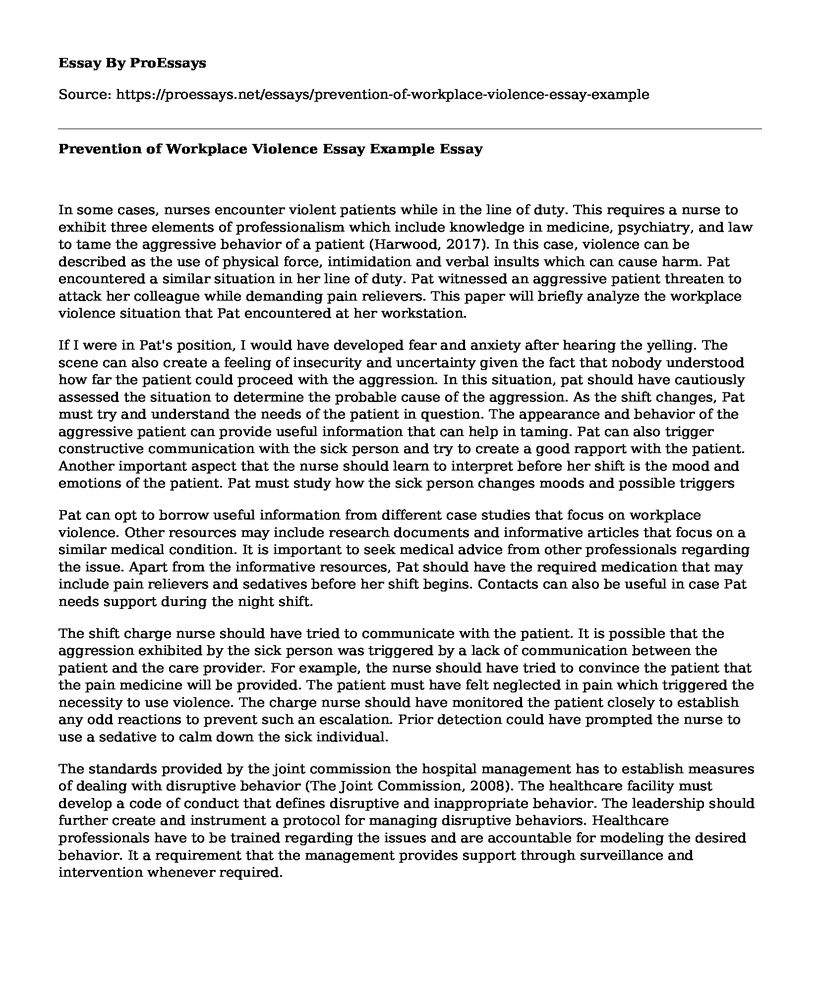In some cases, nurses encounter violent patients while in the line of duty. This requires a nurse to exhibit three elements of professionalism which include knowledge in medicine, psychiatry, and law to tame the aggressive behavior of a patient (Harwood, 2017). In this case, violence can be described as the use of physical force, intimidation and verbal insults which can cause harm. Pat encountered a similar situation in her line of duty. Pat witnessed an aggressive patient threaten to attack her colleague while demanding pain relievers. This paper will briefly analyze the workplace violence situation that Pat encountered at her workstation.
If I were in Pat's position, I would have developed fear and anxiety after hearing the yelling. The scene can also create a feeling of insecurity and uncertainty given the fact that nobody understood how far the patient could proceed with the aggression. In this situation, pat should have cautiously assessed the situation to determine the probable cause of the aggression. As the shift changes, Pat must try and understand the needs of the patient in question. The appearance and behavior of the aggressive patient can provide useful information that can help in taming. Pat can also trigger constructive communication with the sick person and try to create a good rapport with the patient. Another important aspect that the nurse should learn to interpret before her shift is the mood and emotions of the patient. Pat must study how the sick person changes moods and possible triggers
Pat can opt to borrow useful information from different case studies that focus on workplace violence. Other resources may include research documents and informative articles that focus on a similar medical condition. It is important to seek medical advice from other professionals regarding the issue. Apart from the informative resources, Pat should have the required medication that may include pain relievers and sedatives before her shift begins. Contacts can also be useful in case Pat needs support during the night shift.
The shift charge nurse should have tried to communicate with the patient. It is possible that the aggression exhibited by the sick person was triggered by a lack of communication between the patient and the care provider. For example, the nurse should have tried to convince the patient that the pain medicine will be provided. The patient must have felt neglected in pain which triggered the necessity to use violence. The charge nurse should have monitored the patient closely to establish any odd reactions to prevent such an escalation. Prior detection could have prompted the nurse to use a sedative to calm down the sick individual.
The standards provided by the joint commission the hospital management has to establish measures of dealing with disruptive behavior (The Joint Commission, 2008). The healthcare facility must develop a code of conduct that defines disruptive and inappropriate behavior. The leadership should further create and instrument a protocol for managing disruptive behaviors. Healthcare professionals have to be trained regarding the issues and are accountable for modeling the desired behavior. It a requirement that the management provides support through surveillance and intervention whenever required.
Conclusion
As a nurse, the first action is to agree that the patient is right and that his demands will be addressed. This acceptance can help in calming the patient and pave way for mitigation measures. The second strategy is to develop a close relationship with the patient through constructive communication and interaction. This makes the nurse understand the likes, dislikes, preferences, and pains of the patient.
References
Harwood, R. (2017). How to deal with violent and aggressive patients in acute medical settings. J r Coll Physicians edinb, 47, 176-182. doi: 10.4997/JrCPe.2017.218.
The Joint Commission. (2008). Sentinel event alert. Behaviors that Undermine a Culture of Safety, Issue 40, Retrieved from https://www.jointcommission.org/assets/1/18/SEA_40.PDF.
Cite this page
Prevention of Workplace Violence Essay Example. (2022, Oct 20). Retrieved from https://proessays.net/essays/prevention-of-workplace-violence-essay-example
If you are the original author of this essay and no longer wish to have it published on the ProEssays website, please click below to request its removal:
- Definitions and Issue of Incivility in Nursing - Research Paper
- The Pathophysiology of Atherosclerosis, and Hypertension, and Their Current Treatment Regimens
- Paper Example on Medicine-Origin and Chemical Treatment of Asthma
- Nosocomial Infection Prevention: Evaluating the Health Belief Model - Research Paper
- COVID-19: Global Outbreak From China to Antarctica - Essay Sample
- Essay Example on Unlock Motivation: The Life of Robert Frost, Poet & Motivator
- Essay Sample on Vitamin A: Essential for Vision, Growth and Immunity







